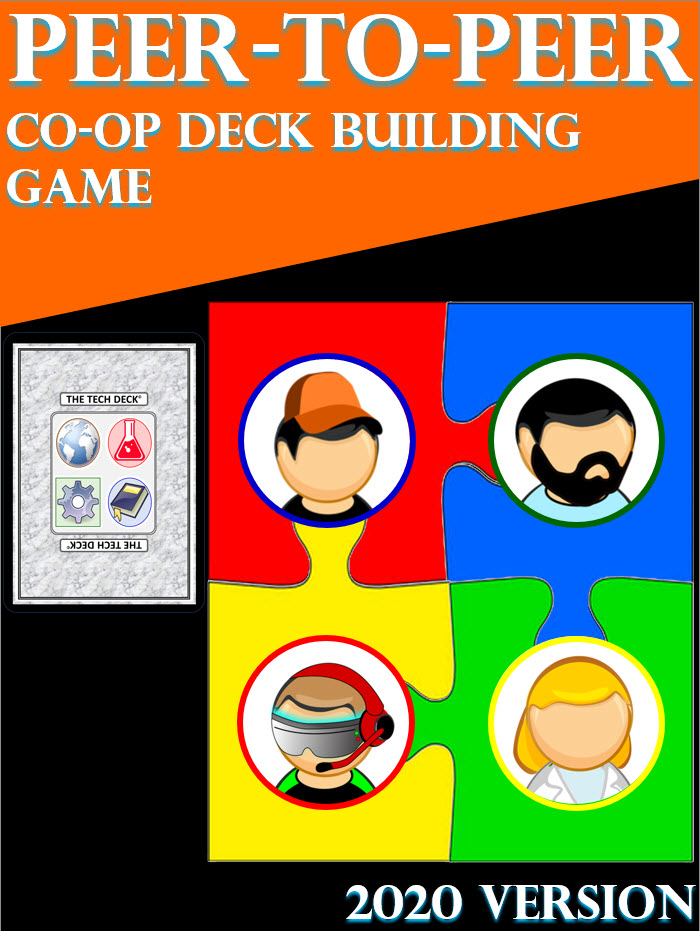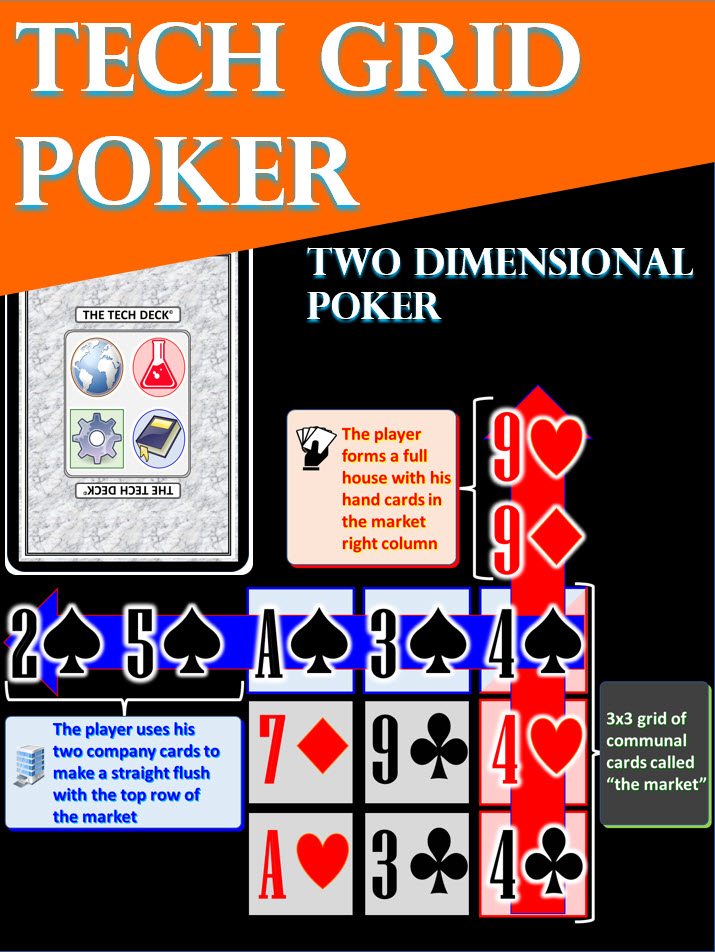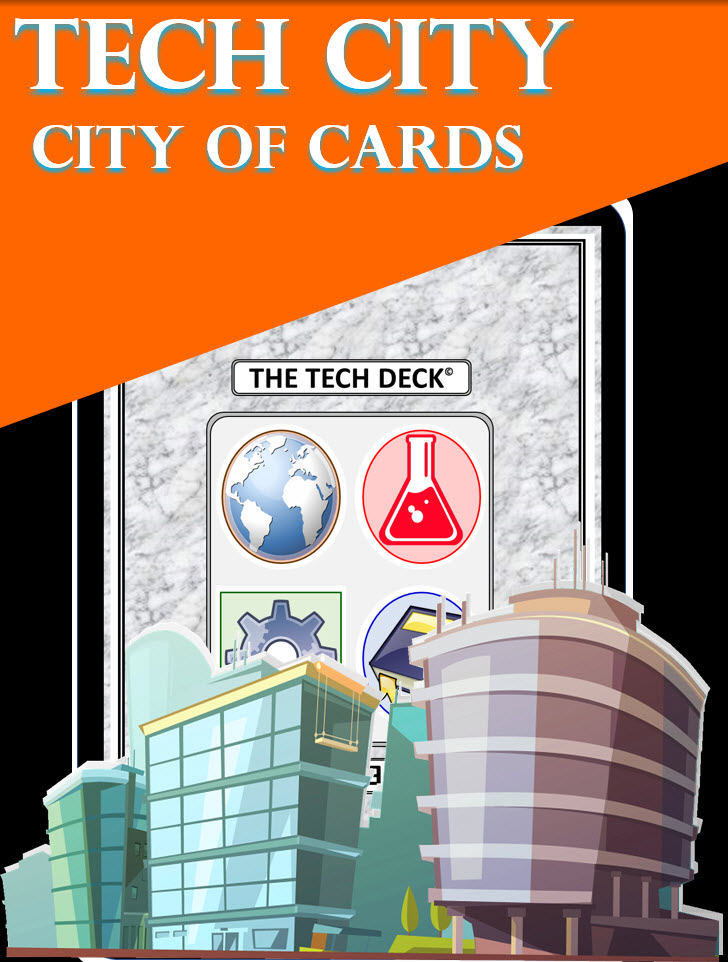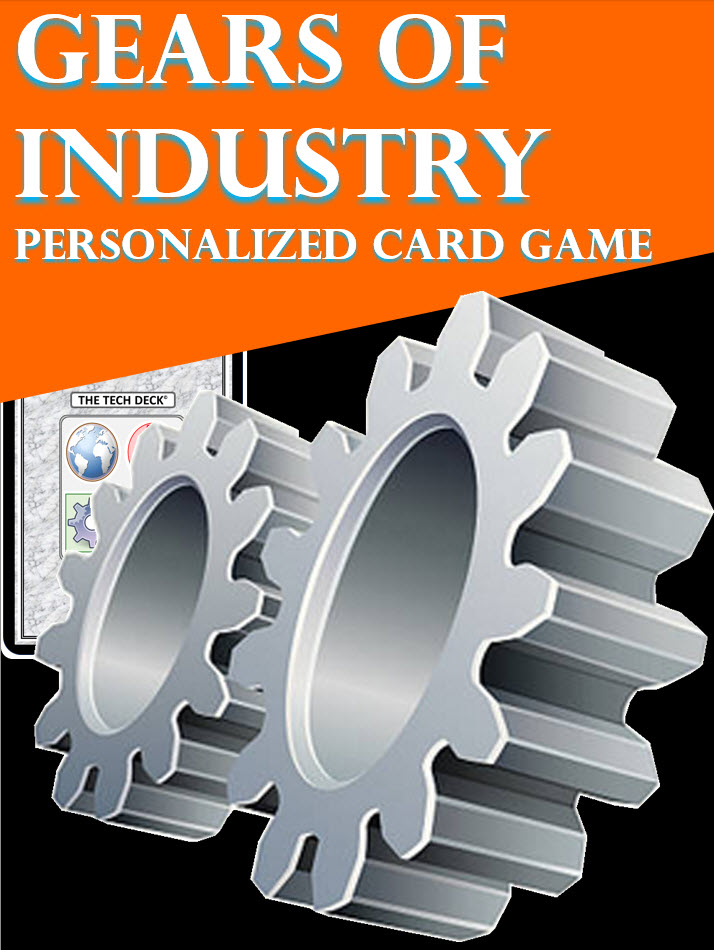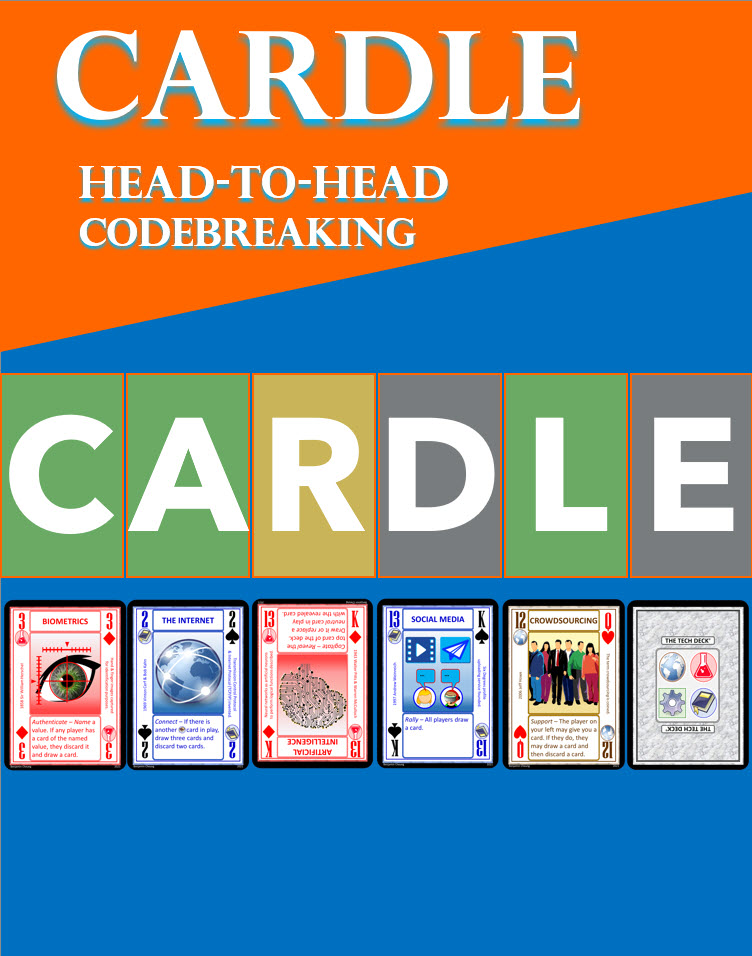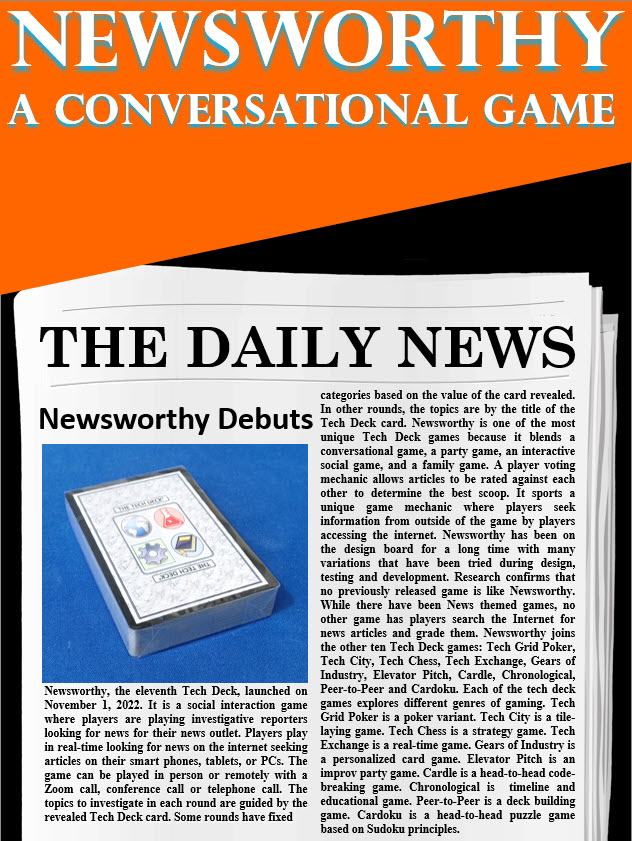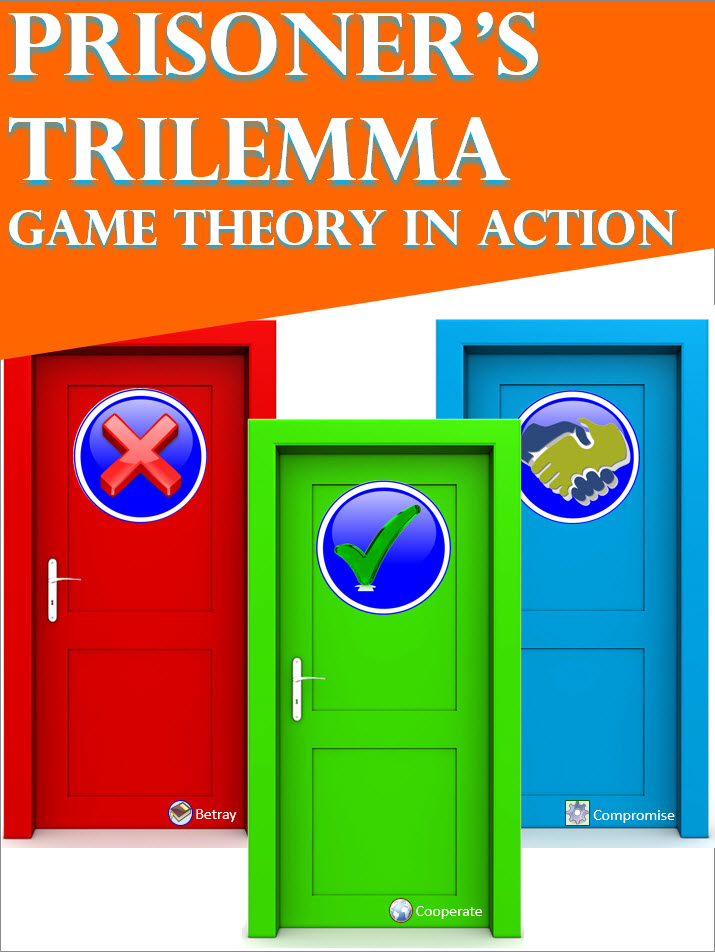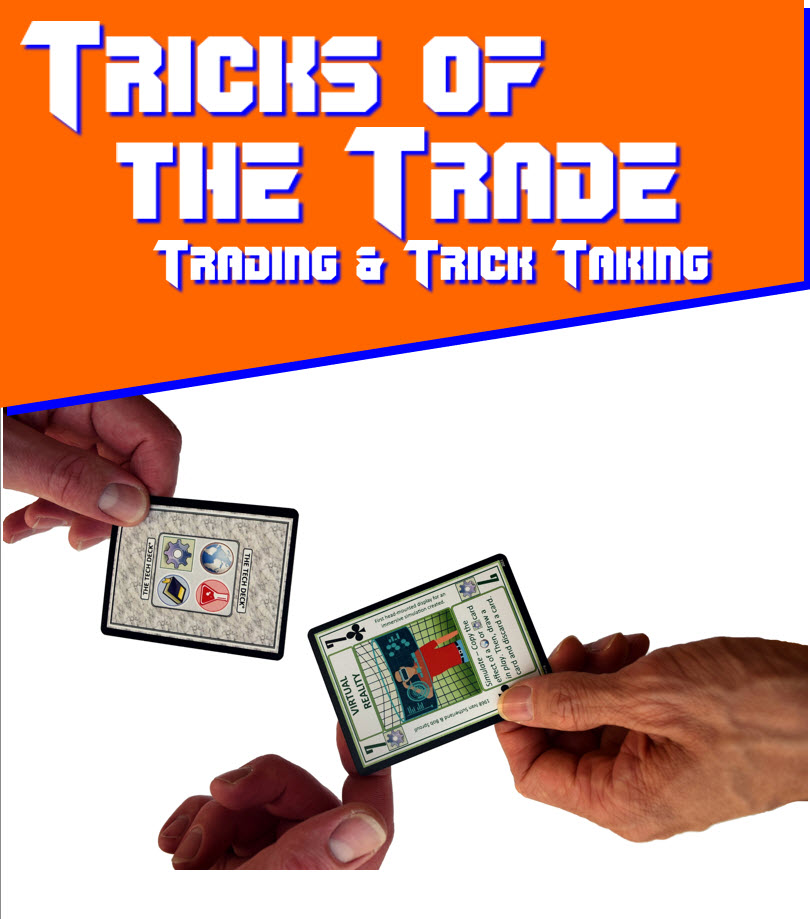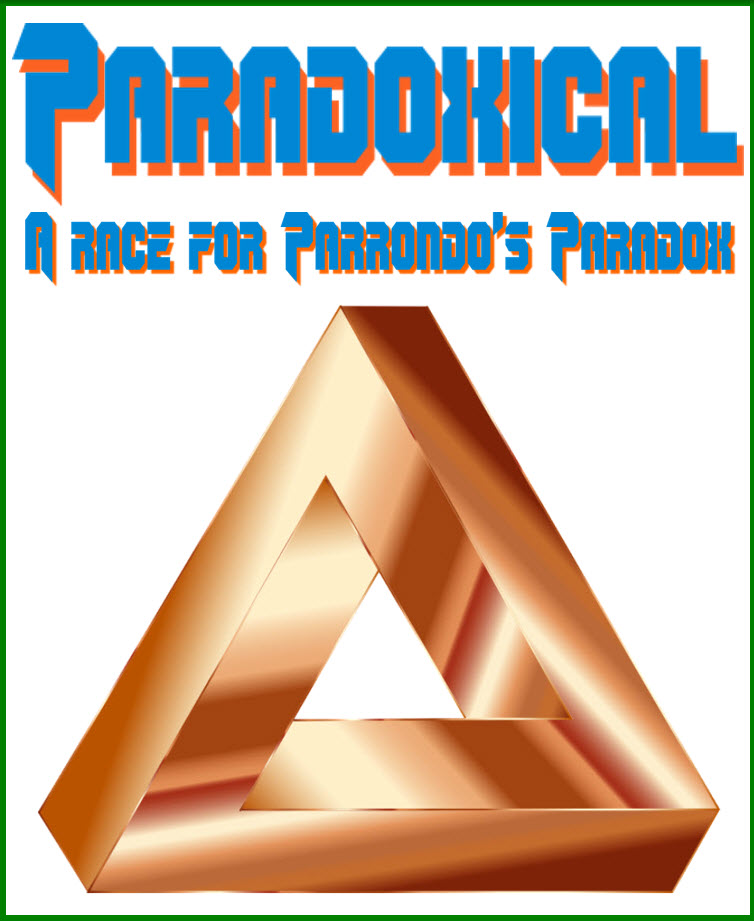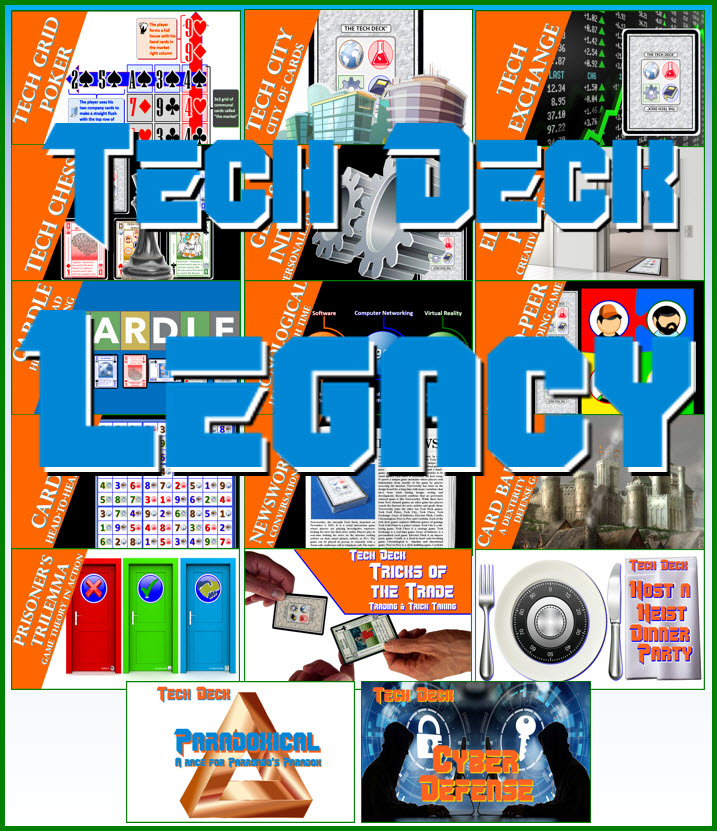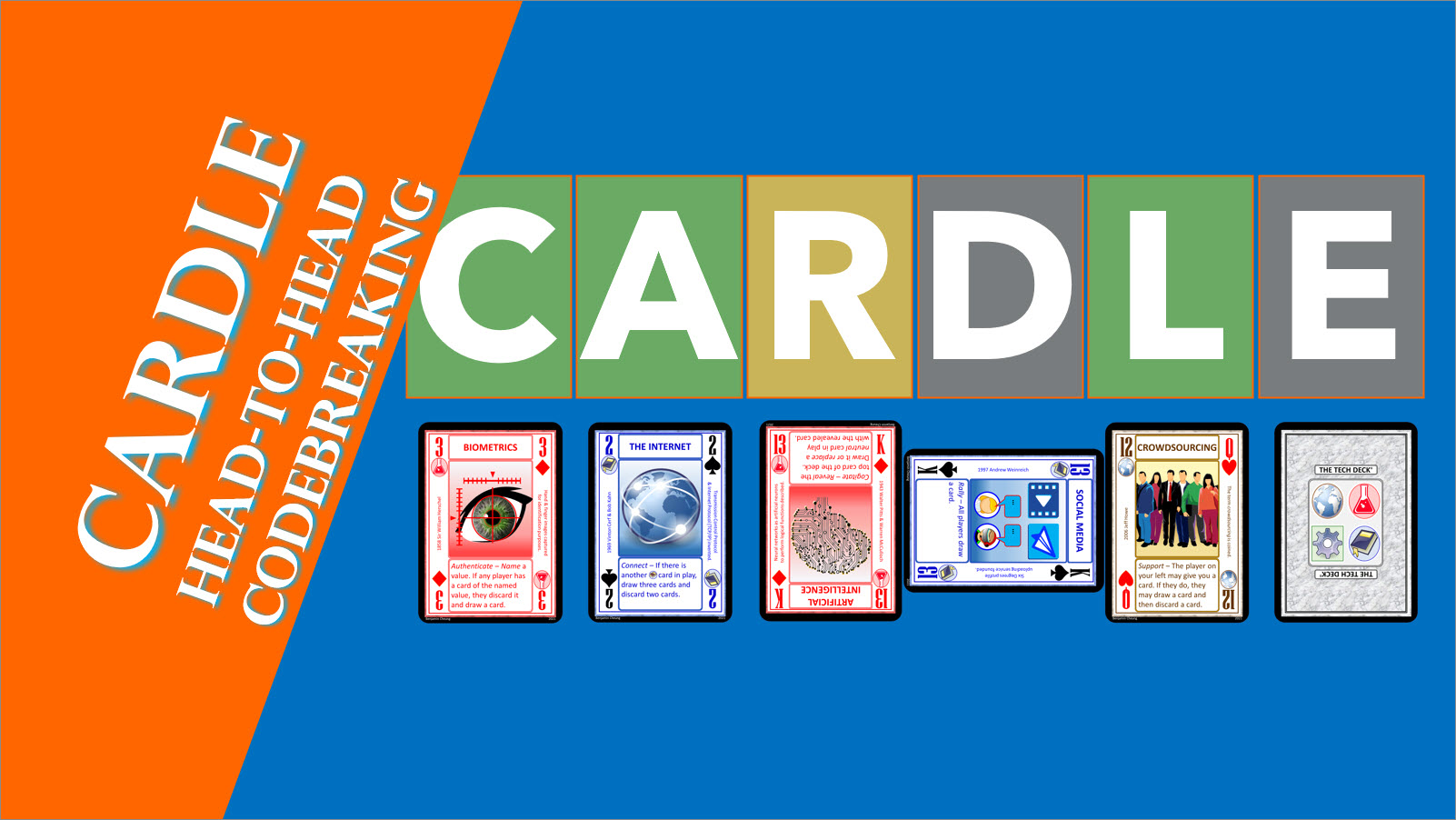
OBJECTIVE & CONCEPT
Cardle is a Tech Deck game where players try to crack a hidden 6-digit code encoded in face-down Tech Deck cards administered by a codemaster. Players have seven tries to break the code. The code master selects the code and provides clues as players try to deduce the secret code.
OBJECTIVE - Players have seven tries to break a code that is selected by the code master.
THEME - The theme of the game is cryptanalysis by head-to-head code-breaking.
WINNING - In cooperative mode, the players win by guessing the values of each of the positions of the secret code. In head-to-head mode, a player/team wins if they guess the exact cards (value and domain/suit) of the secret code. If after 7 turns, neither player/team has guessed the code they are awarded points based on how close to the secret code they are.
DEDUCTION GENRE
A deduction game involves solving a puzzle or mystery. The players use logical deduction based on information they gather to reach a conclusion.
CRYPTOGRAPHY uses codes and ciphers to protect secrets. It has roots in 2000 BCE in Egypt. Cryptography is used to transform information into an unintelligible form for transmission or storage so an unauthorized user cannot access it.
CRYPTANALYSIS is the "breaking" of codes and ciphers. Breaking encrypted communications has altered the course of history. The Zimmermann Telegram triggered the USA to enter World War I.
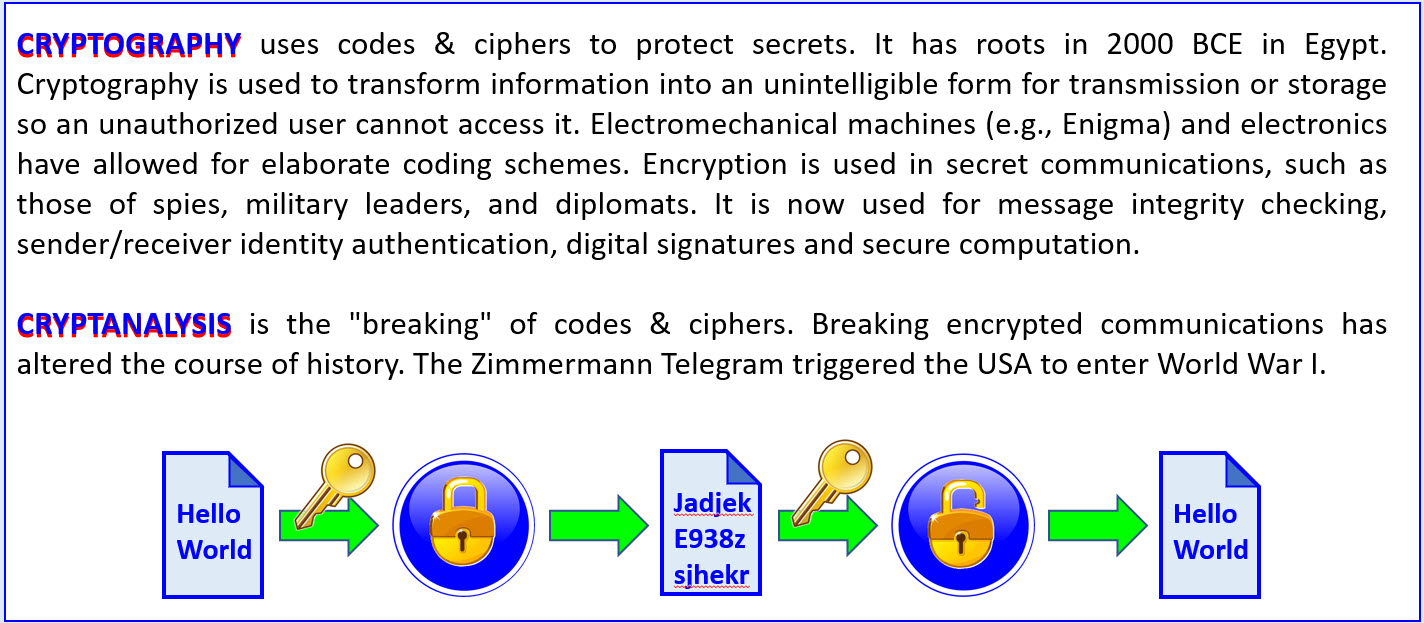
GAMEPLAY OVERVIEW
GAME PLAY - The game can be played in cooperative or head-to-head mode. In cooperative mode, there is one codemaster and all the other players are trying to guess the code. In head-to-head mode, two players or two teams are simultaneously trying to break the code of the other player/team. Each player/team has a Tech Deck. Each player/team serves as the codemaster for the other player/team. Players make an educated guess using their Tech Deck cards. Cards placed as a guess are called guess cards. After making a guess, the codemaster rotates the guess cards to provide information about the secret code for each of the guess cards in their positions of the code. A guess card can be an exact match, value match, displaced, or absent.
GAME SETUP FOR GROUP PLAY
Group Play Mode uses one Tech Deck
STEP 1: CODEMASTER -
If playing in group play mode there will be one person managing the code, called the Codemaster. All other players are trying to break the code together. Group play uses one Tech Deck. Expel the wild cards.
STEP 2: SETUP THE CODE -
The Codemaster looks through the Tech Deck and chooses six cards and their order representing the code that needs to be broken. The code may not contain more than 2 of the same value card. Place the code cards in a row face down in the play area. Shuffle the Tech Deck.
STEP 3: DEAL PLAYER CARDS -
Deal the other players 10 cards.
STEP 4: DECK & DISCARD -
Place the remaining cards of the deck next to the play area. The discard pile will be next to that.

GAME SETUP FOR HEAD-TO-HEAD CARDLE
Head-to-head Cardle uses two Tech Decks.
STEP 1: HEAD-TO-HEAD PLAY -
If playing in head-to-head (H2H) mode, two players or teams are playing against each other. Head-to-Head mode uses two Tech Decks. Each player/team is trying to break the other player’s/team’s code at the same time. One player/team will serve as the Codemaster for the other player/team. Each player/team will use a separate Tech Deck. Teams do not have to have an equal number of players. Expel the wild cards.
STEP 2: SETUP THE CODE -
Each player/team looks through their Tech Deck and chooses six cards and their order representing the code that needs to be broken. The code may not contain more than 2 of the same value card. Place the code cards in a row face down in front of the other player/team. Each player/team then shuffles their Tech Deck.
STEP 3: DEAL PLAYER CARDS -
Each player/team draws 10 cards into their hand.
STEP 4: DECK & DISCARD -
Each player/team places the remaining cards of their Tech Deck next to them. Their discard pile will next to that.
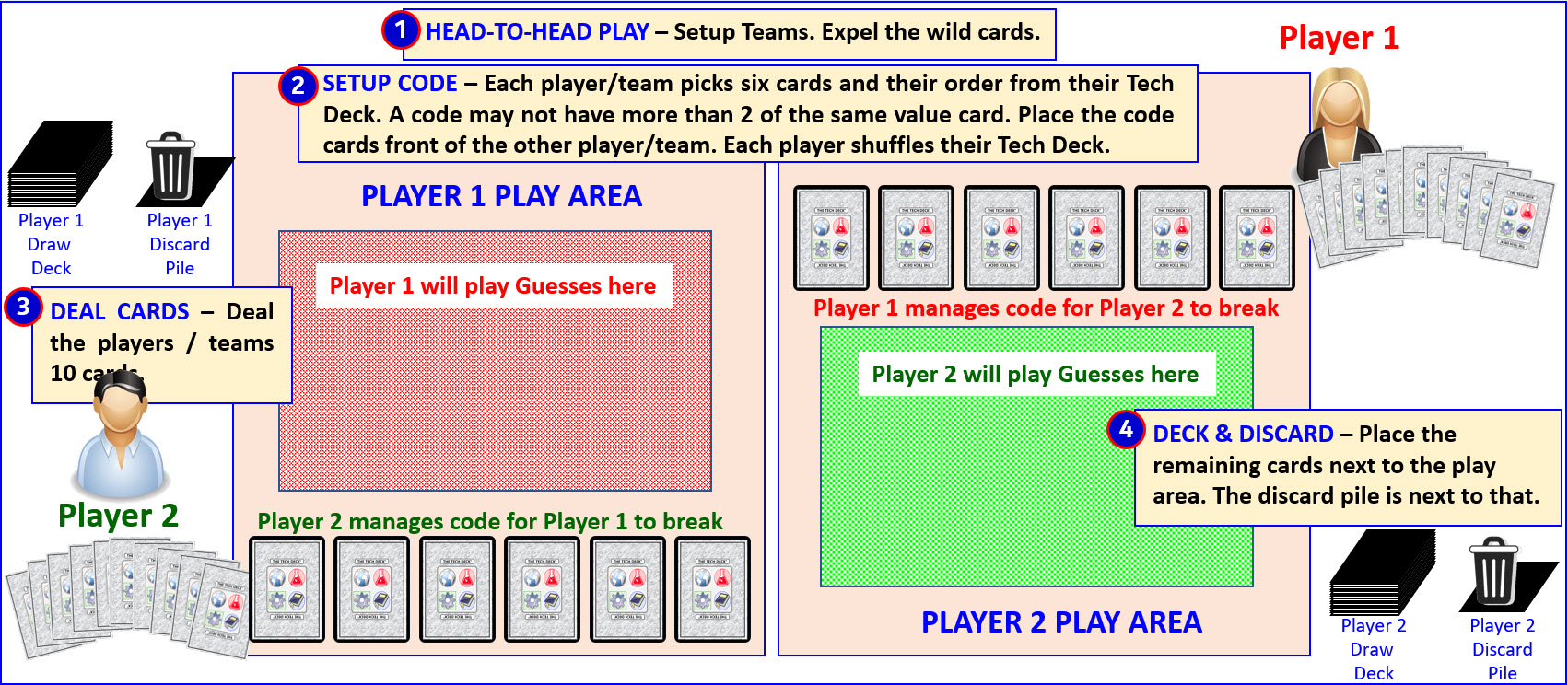
STEPS IN GAMEPLAY
Each turn, players get to make an educated guess trying to deduce the secret code:

MAKE A GUESS -
Group mode: players make a guess by placing 6 guess cards face up beneath the code. H2H Mode: each player/team makes a guess against the other player’s/team’s code by placing 6 guess cards under the code cards face down. Then both players turn over all their guess cards simultaneously.
SET CLUES FOR GUESSES -
The guess cards are rotated to give clues about the code. There are four cases:
EXACT MATCH -
If a guess card is an exact match (value & domain/suit) for that position, turn over the Code card.
VALUE MATCH -
If the card matches the value but not the domain/suit turn the guess card upside down (180').
DISPLACED -
If the value of a guess card is in the code but in the wrong position, turn the guess card sideways (90')
ABSENT -
If the value of the card is not in the code at all, the guess card is not changed.
DRAW CARDS -
Group mode/H2H Mode: Players draw cards until they have 10 cards in hand.
DISCARD TO DRAW CARDS -
As players get more information about the code, some cards will be “dead cards”. At any time, and any number of times during the turn, players may discard 2 cards to draw a card from their draw deck.
CARRY FORWARD CARDS -
Due to a limited number of cards, after guessing and drawing, players may “carry forward” guess cards from any prior round into the next round’s guess. Maintain the orientation of the forwarded guess cards.
END OF GAME -
Group mode/H2H Mode: The game ends when the code is solved, or after 7 rounds of guessing. H2H mode: If neither player/team has solved the code after 7 rounds, award 3 points for each exact match, 2 points for each value match, and 1 point for each displaced card in the final guess.
EXAMPLE OF GAME PLAY
SETTING CLUES FOR HEAD-TO-HEAD PLAY
The following diagram illustrates an example setting the code cards for Head-to-Head play.
The guess cards are: 13-Knowledge, 13-Science, 2-Knowledge, 3-Science, 10-Science and
12-Service. The 13-Knowledge was an exact match so the Code card is revealed.
There is a 13 in the code in the second position so the 13-Science is turned upside down.
There is a value 2 card in the code but not in the 3rd position (displaced), so the 2-Knowledge
is rotated on its side.
The 3, 10, and 12 are untouched, so those values are not in the code.

SETTING CLUES FOR GROUP PLAY
The following diagram illustrates an example setting the code cards for Group Play mode.
For group play, setting the clues is similar to Head-to-head play. The difference is that because
the game is played with one Tech Deck, it is impossible to have an exact match.
In this case, there is a 13 in the first and second position of the code. Both the 13-knowledge and
13-science are turned upside down. There is a 2 in the code so the 2-knowledge is turned sideways.
The 3, 10, and 12 are untouched, so those values are not in the code.
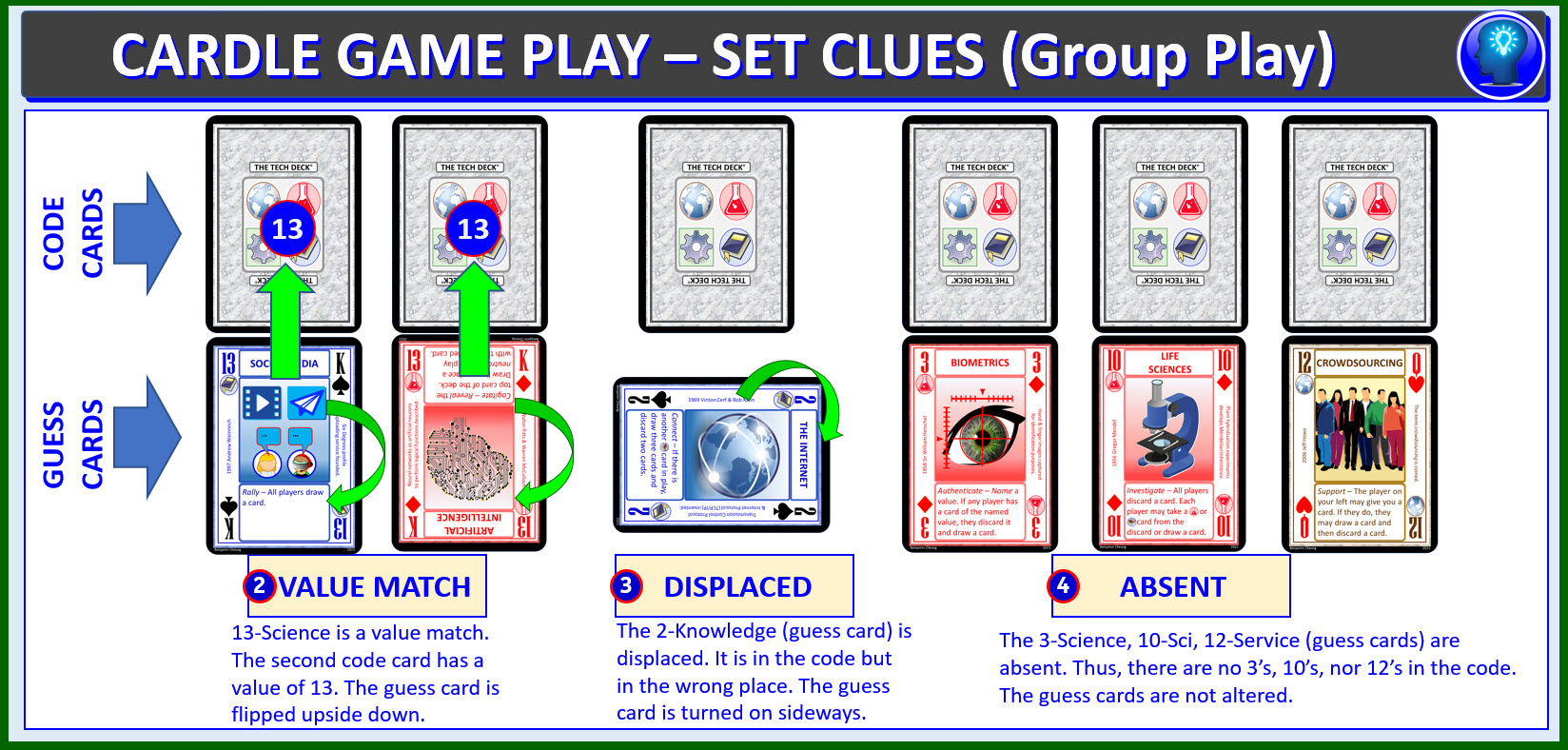
MAKING A GUESS IN HEAD-TO-HEAD PLAY
The following diagram illustrates an example making a guess with Tech Deck cards in Head-to-Hed Play.
In this example, we see two turns. The first turn the set of guess cards are shown as "Guess #1 cards".
the second turn with "Guess #2 cards.". The player decides to carry forward the 13-knowledge and
the 13-science. He knows that there is a 2 in the final code but not in the 3rd position, so
he plays a value 2 in the fifth position. He could have carried forward the 2-knowledge and placed
it in the 5th position (or any other position). Note that even though the player knows there is a
13-knowledge in the first position, he may play any other card in the first position to gain more
knowledge about the code.

WINNING THE GAME
END OF THE GAME -
Group mode/Head-to-head Mode: The game ends when the code is solved, or after 7 rounds of guessing.
H2H mode: SCORING: If neither player/team has solved the code after 7 rounds, award 3 points for each exact code card match in the final guess (both value and domain/suit). Award 2 points for each final guess card that has a value match to a code card in that position. Aware 1 point for each displaced guess card in the final guess, which is a guess card that has its value in the code but not in the correct position.
DOWNLOAD THE RULES
Cardle Full Rules:
Cardle Rules
INTRODUCTION VIDEO
Watch a video on the introduction of Cardle.
The introduction video describes the basic concepts, objectives and an
introduction to the Tech Deck.
PLAY GUIDE VIDEO
Watch a play guide video for Cardle.
The play guide video is an in depth video on how to setup the game,
and all the steps involved in playing the game.
ENTRY ON BOARD GAME GEEK

You can read and explore the
BoardGameGeek entry for Cardle.
PUBLICATION INFORMATION
·
Published: May 31, 2022
·
Format: Card Game
·
Elements: 54 Cards
·
Size: 3.75" x 2.8751" x .875"
ORDERING CARDLE
·
To purchase the Tech Deck:
Contact Me
EXPLORE OTHER GAMES

